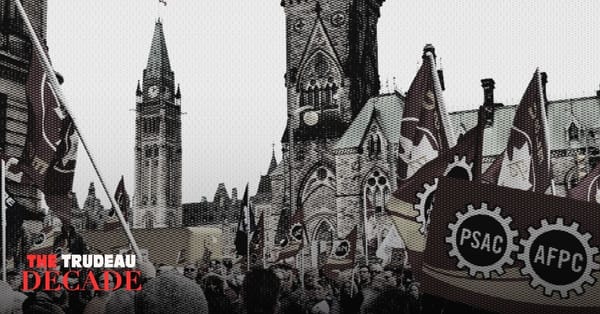Ontario Premier Doug Ford has announced his intention to crush free and fair collective bargaining.
Served to an emergency 5 a.m. session of Ontario’s Legislative Assembly, the Keeping Students in Class Act will circumvent collective bargaining and impose a contract on more than 55,000 educational support workers unionized with CUPE who are threatening to walk off the job tomorrow. The act also promises a daily fine of up to $4,000 for individual employees who refuse to work. It’s an authoritarian attack on the education sector’s poorest workers.
Wages for these workers have effectively suffered a 10.2 per cent real wage cut over the past decade, with 98 per cent of them who are women earning less than $60,000. More than half of these workers have multiple jobs to make ends meet, and 60 per cent are laid off every summer. These are the workers who sit with students who need extra help, who bring the sawdust to class when little Jaxxon barfs, who keep the hallways clean and bathrooms usable, and get rid of broken classroom chairs. They’re the backbone of the system and they’re paid garbage wages. It’s no surprise that these conditions led to a 96.5 per cent strike mandate.
In 2015, the Supreme Court of Canada ruled that collective bargaining is a constitutionally-protected right. This means that for Ford to be able to impose this contract on these workers, he’ll need to invoke the notwithstanding clause. Prior to Ford, it had never been used in Ontario. If he goes through with it, it will be the second time he has done so since taking power in 2018, and the third time he has discussed it. (Law professor David Doorey wrote a backgrounder about this legislation and the constitution if you’d like to learn more.)
Ford’s actions follow a series of increasingly authoritarian legal manoeuvres taken by both Conservative and Liberal governments. For example, governments have used back-to-work legislation to intervene in collective bargaining processes and stop workers from continuing strikes. The federal Liberals used back-to-work legislation to end a strike at the Port of Montreal in 2021, and against postal workers in 2018. The Conservatives used it to end strikes in air, rail and postal service strikes. In 2018, Ford used it to end a strike at York University, and in 2015 the Ontario Liberals used it to crush strikes in three school boards. In this case, however, workers aren’t even on strike yet. The act isn’t back-to-work legislation, but rather a preemptive attack on workers.
The ability to walk off the job is fundamental to workers’ rights — no government, boss or corporation can force a worker to labour under conditions they refuse. This right was established following a 1945 strike by the United Automobile Workers of Canada in Windsor that laid the foundation of modern labour negotiations here. The Rand Formula, named after the Supreme Court justice that made the decision on the strike, declared that workers had the right to bargain, including the right to go on strike, in return for only doing so during specific periods of contract negotiations.
The Rand Formula was a compromise, regarded as being important for workers and bosses, as both sides got something from the decision. The Canadian Encyclopedia notes that the Rand Formula is “credited with taking ‘management-labour disputes out of the brick-and-tear-gas stage’ and providing unions with a steady financial foundation.” Does Ford really want to undo this peace? Does he really want to gamble on the idea that workers won’t take militant action to fight back?
Underlying this struggle is that people in Canada, especially low income ones, who are among CUPE’s educational worker membership, are experiencing historic levels of financial hardship. Meanwhile, for the first time ever, corporate profits as a percentage of Canada’s GDP reached 20 per cent. Record profits are everywhere these days, including for grocery chains, oil and gas companies, telecoms and banks. The flip side of these record profits, however, is stagnant wages: nearly two thirds of public sector workers have experienced effective wage loss over the past two years, according to an April report from economist David Macdonald. At the same time, the average Canadian household owes about $1.82 for every dollar of disposable income they have, a near-record high.
Last fiscal year, Ford’s government managed to cut enough money off spending to post a $2.1 billion surplus. The issue isn’t that the government can’t pay for what workers are demanding. Instead, Ford wants to put the boots to the poorest education workers in Ontario. He’s doing this because he can and it’s easier than going through the hassle of negotiating, just like it was easier for Prime Minister Justin Trudeau to invoke the Emergencies Act than to manoeuvre around inept and Convoy-supportive police forces to end the trucker occupation in Ottawa with the tools available in the Criminal Code.
It’s not just that these tactics are easier, though. Aside from entrenching poverty wages, worker subjugation and power, it’s also about getting people used to seeing politicians opt for the most forceful option available. And sadly, both Ford and Trudeau’s decisions show that strong arm tactics can be popular for a political base.
Sure, the notwithstanding clause has always been part of the current Charter, but no one was ever supposed to use it, right? Labour has to fight this with everything they have, and Ontarians need to be right behind the unions.







